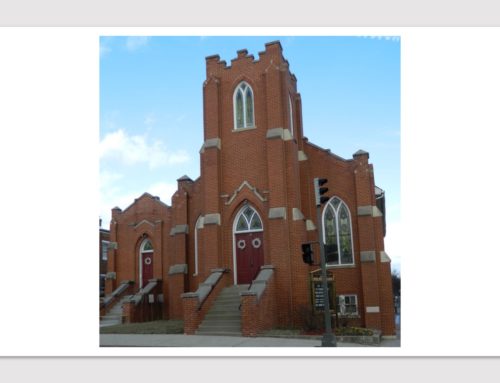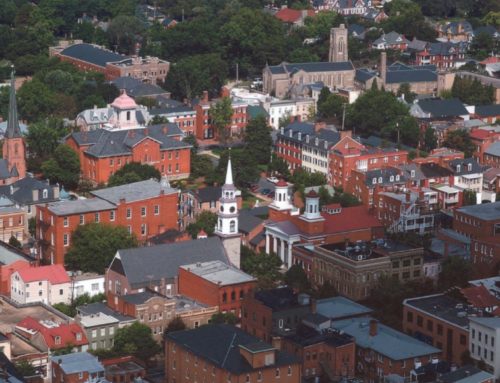Excerpt from the Frederick News-Post:
The only building left from early 19th-century tanning operations in the city of Frederick may be demolished to build a downtown hotel and conference center, according to a project update on Thursday.
Pete Plamondon Jr., co-president of Plamondon Hospitality Partners, the hotel developer for the project, said the proposed final design does not include the Birely Tannery building. Design plans are being revised, and will not be publicly presented or submitted for necessary city review until at least next month, Plamondon said in an interview on Thursday.
The latest plan calls for a 200-room hotel and 24,000 square feet of conference center space with on-site parking and infrastructure improvements at the site of the old Frederick News-Post building.
The property at 200 and 212 E. Patrick St. is owned by a business entity formed by members of the Randall family. The Randall family also owns the parent company of The News-Post.
Based on prior renderings submitted in Plamondon’s response to the city’s request for proposals, some people anticipated that the understated white brick building facing the Carroll Street side of the property might be demolished. That expectation wasn’t confirmed until Thursday; project planners had insisted that the renderings were preliminary and subject to change.
Local preservation advocates have opposed the anticipated demolition of the tannery, highlighting its importance as the last remnant of a once-booming tanning industry concentrated along Carroll Creek.
However, Kann Partners, a Baltimore-based consultant retained by Plamondon Hospitality Partners to research and facilitate applications related to historic preservation, concluded that the tannery is ineligible for the National Register of Historic Places, according to information presented Thursday.
This conclusion and accompanying research will be submitted to the Maryland Historical Trust, which has final authority to determine if the tannery can be on the National Register. The city Historic Preservation Commission will weigh in on the building’s historical significance as it relates to the Frederick Town Historic District.
The local preservation commission and the state agency can each independently determine whether the tannery is historically significant. The rulings do not have to agree. Locally, a conclusion that the tannery is significant in the context of the historic district can, but does not have to, preclude demolition.
History in context
Kann Partners began research in January on the building’s significance related to the tanning operations.
Prior to that, little was known about the Birely Tannery’s origins, apart from a report of evidence found by a Delaware excavating company during its investigation into the site’s historical significance at the start of the Carroll Creek Flood Control project.
Mimi Giguere, director of historic preservation for Kann Partners, on Thursday detailed the firm’s evaluation of the existing building related to the criteria for the National Registry, which include historical significance connected to events, people, design and information potential.
The new information came from a study of historic 18th- and 19th-century maps and documentation through the Maryland Historical Trust and the Maryland Room at the C. Burr Artz Public Library downtown, Giguere said in an interview.
Based on this evidence, in conjunction with MAAR Associates’ report, Giguere said the firm did not find the building eligible for the national register.
“The real association to the original period is mostly gone,” she said, noting that other buildings included in the Birely Tannery business are gone, as is direct access to the creek. “Nothing on the site says ‘I’m a 19th-century tannery.’ It’s a small building sitting in the middle of the parking lot.”
Some local preservationists argue the opposite — the building is significant because it is the only structure left from the city’s once-thriving tanning industry.
Anthony Moscato, chairman of the local preservation advocacy group Frederick Preservation Trust, is one. Moscato is married to Scott Winnette, chairman of the Historic Preservation Commission.
In an interview Thursday, Moscato said it was a “definite possibility and probability” that the tannery could be deemed significant under city guidelines.
Christina Martinkosky, a city historic preservation planner, noted that the standards for a national register designation were much stricter than those locally standards.
Next steps
Additional archaeological research is required as part of the state determination of eligibility. Archaeological testing will begin Wednesday, according to Plamondon Hospitality Partners.
The review process will last several weeks, culminating in a report to the Maryland Historical Trust as part of its review, Giguere said.
Even if testing reveals additional information or historic resources related to the tannery, Giguere maintained that the building itself was not significant for a register designation.
“It may be eligible archaeologically, but not as a building,” she said.
Both the final submission to the Maryland Historical Trust and the design plans in the application to the HPC are targeted for September completion dates.
Plamondon has sought input from local architecture firm Bates Architects in shaping the new design to meet city preservation guidelines. Bates Architects has worked extensively on projects within the Frederick Town Historic District, firm representatives said after the meeting Thursday.
This input, in conjunction with extensive work to preserve and renovate the facade of the 1911 trolley building, will make for a “great project,” Pete Plamondon said.
To those who critiqued the project from design or preservation standpoints, Plamondon said, “I think people should withhold comment until they see what’s going to be presented.”



